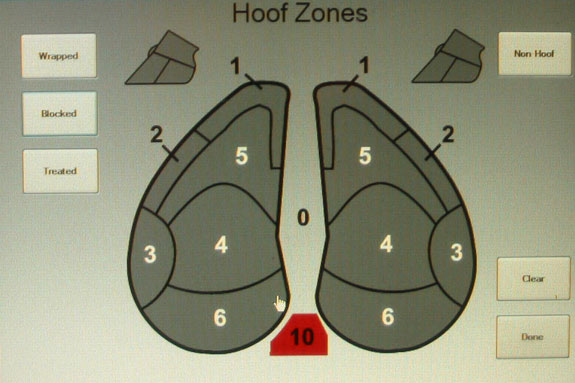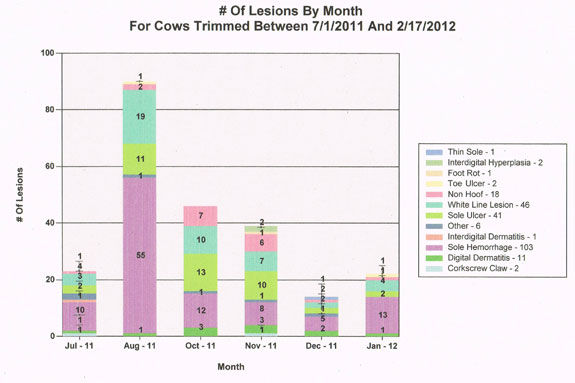As a follow-up to his popular article, "Individual cow care to lower lameness in your herd," we asked author Jamie Sullivan the following question: Q. Have lameness incidents continued to decline or have they remained about the same? What's the next step in hoof health beyond a focus on individual cow care? In this herd and my other clients' herds that have adopted the “individual cow care and 150-day trim protocol," we have seen continued improvement in hoof health. Does that mean we don’t have some months where there is an increase in lameness? No.
 Photos courtesy of Jamie Sullivan.
Photos courtesy of Jamie Sullivan.
As we know, the cause of lameness is multi-factor and some of these factors are out of our control. For example the herd that was featured in the last article we saw a dramatic increase in hoof lesions in the month of August. This was mainly due to hot and humid weather through the later part of June and the July.
The cows were heat stressed and the floors were a little more slippery than normal. The main sources of the lame cows were sole factures or heel ulcers in zone 6 (pictured at right) and mainly on the medial claws. Some of this was due to increase standing and perching in the stalls but we also had a talk with the milkers.
The cows were being “rushed” a little too quickly to the parlor, combined with the more slippery floors, increased the number of white line lesions and the main source to the heel ulcers and sole factures.

With the improved cow handling and return to normal temperatures, hoof health improved as quickly as it declined with December trim results, showing 77 percent cows trimmed with no lesions to report and only one lame cow to be treated ( Figure 1 ).
The greatest advantage to getting lameness under control and by keeping good hoof health records is that when there is an increase in lameness and/or hoof lesions, the source usually can be discovered more quickly and an action plan implemented quickly.
In most instances in the larger herds where I visit more frequent we will start to see an increase in hoof lesions and severity of the lesions before we see a dramatic increase in lameness. By closely monitoring the hoof health records we can source the factor(s) and resolve the issue before it has a dramatic effect on the herd’s overall lameness incidents.
As for the next steps in hoof health beyond a focus on individual cow care there are a couple more management issues to focus on and then there is the team approach to herd health. First, if you want to make another step to achieving a very low incidence of lameness in your herd you need to be trimming all your pre-fresh first lactation heifers.
By trimming your pre-fresh heifers 6-8 weeks before her calving date you will insure she has a balance foot when she starts her lactation. You will see some of your greatest return on investment (ROI) on the dollars spent on your herds hoof trimming by trimming the pre-fresh heifers. You will not only see much lower incidents of claw horn lesions but you will see an increase in production in your first lactation heifers.
Second, the key to any herd’s hoof health is having a good foot bath protocol. Digital Dermatitis (DD) is the number one cause of lameness today, yet it is the easiest lesion to get under control. It can, for some herds, take a lot of time, energy and effort but I say easy to control because it is not a multi-factor lesion.
We have learned a lot about the bacteria that causes DD and one thing is that it is the same bacteria that cause cavities. Second it is a bacterium that does like oxygen, so the cleaner we can keep the cow’s foot, the lower number of these bacteria that can survive.
Also can you imagine your dentist bill if the only time your teeth were cleaned was on your appointment once or twice a year? Well I have some clients whose hoof hygiene protocol is basically on hoof trim day!
One of the questions I get asked the most is, "How often does a footbath need to be run?" The answer: as often as it takes to achieve results. That could be once a month for one herd, and it could mean once a milking for another.
Another way to help dramatically reduce the incidents of DD in your herd is once a week or so topically spray DD in the parlor during milking. I recommend to my clients a topical spray of a footbath booster and copper sulphate diluted in water.
Third is the “team approach” to hoof health. I’m fortunate to have a pretty good relationship with the nutritionists and veterinarians with most of my clients.
Once you start keeping good records, the next step is sharing them to all parties involved in that herd. We all need to be on the same page on where and which direction the herd is going. All of us that service our dairy clients need to be careful not to become “blind” to the issues in front of us.
We need to work together as a team, we need to keep the communication lines open and we need to help each other to ensure we are all doing all we can for our “real clients” – the cows. We are all on the farm on a different day, we all see things with a different set of eyes and perspectives, and we all have different strengths and weaknesses.
We need to pool all this together in a team approach and deliver a common goal and solutions to our dairy clients. Let’s keep the communication lines open and realize what has worked in the past may not be the solution for present.








